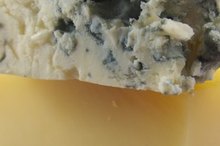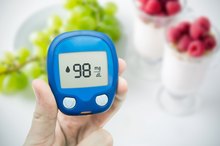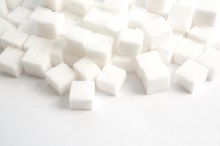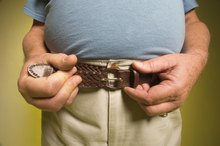How Is Starch Stored in Humans?
Starch is a part of a well-balanced diet. Starch is a carbohydrate, the kind of macronutrient that should make up the bulk of your diet. When you digest starch, it is broken down into its simplest form and the excess is stored for later use. However, unlike plants, the human body stores starch in a different form.
Starch
Starch is a carbohydrate and like any other dietary carbohydrate, your body breaks it down during digestion. Starch digestion begins in the mouth as the enzyme salivary amylase begins to breakdown the complex structure of starch. Digestion halts in the stomach and begins again as the food enters your small intestine. Starch gets broken down until it is a monosaccharide known as glucose.
- Starch is a carbohydrate and like any other dietary carbohydrate, your body breaks it down during digestion.
- Starch digestion begins in the mouth as the enzyme salivary amylase begins to breakdown the complex structure of starch.
Glycogen
Is Glucose Stored in the Human Body?
Learn More
Glycogen is the body's storage form of starch, though it is technically glucose. To understand this, you must understand that starch is a plant's storage form of glucose. However, as humans, we store the same glucose as glycogen. Our body is equipped to contain excess glucose molecules as glycogen rather than starch.
- Glycogen is the body's storage form of starch, though it is technically glucose.
Storing Glucose
After you eat a meal, your body releases the broken down carbohydrates, including starches, as glucose into your bloodstream. This raises your blood glucose levels, which initiates the release of the hormone insulin. This hormone triggers your cells to take in the glucose from your blood and either use it for energy or store it as glycogen for later use. Most all of your cells do this, including your liver, which stores more than its fair share because it helps to regulate your blood glucose, releasing stored glycogen during times of low glucose.
- After you eat a meal, your body releases the broken down carbohydrates, including starches, as glucose into your bloodstream.
- Most all of your cells do this, including your liver, which stores more than its fair share because it helps to regulate your blood glucose, releasing stored glycogen during times of low glucose.
Sources and Considerations
What Is the Function of Lactose?
Learn More
Starch is found in many commonly eaten, plant-based foods. These include breads, potatoes, peas, corn and beans 3. Some starches are very easily digestible and can impact your blood glucose rapidly. People who are diabetic may want to control their starch intake for optimal blood glucose control.
- Starch is found in many commonly eaten, plant-based foods.
- People who are diabetic may want to control their starch intake for optimal blood glucose control.
Related Articles
References
- "Nutrition: Concepts and Controversies"; Frances Sizer and Eleanor Whitney; 2004.
- "Anatomy and Physiology"; Kenneth S. Saladin; 2004
- American Diabetes Association: Diabetes Myths
- Al-Mana, N. M., & Robertson, M. D. (2018). Acute Effect of Resistant Starch on Food Intake, Appetite and Satiety in Overweight/Obese Males. Nutrients, 10(12), 1993. doi:10.3390/nu10121993
- Bindels, L. B., Segura Munoz, R. R., Gomes-Neto, J. C., Mutemberezi, V., Martínez, I., Salazar, N., … Ramer-Tait, A. E. (2017). Resistant starch can improve insulin sensitivity independently of the gut microbiota. Microbiome, 5(1), 12. doi:10.1186/s40168-017-0230-5
- Canani, R. B., Costanzo, M. D., Leone, L., Pedata, M., Meli, R., & Calignano, A. (2011). Potential beneficial effects of butyrate in intestinal and extraintestinal diseases. World journal of gastroenterology, 17(12), 1519–1528. doi:10.3748/wjg.v17.i12.1519
- Haub, M. D., Hubach, K. L., Al-Tamimi, E. K., Ornelas, S., & Seib, P. A. (2010). Different types of resistant starch elicit different glucose reponses in humans. Journal of nutrition and metabolism, 2010, 230501. doi:10.1155/2010/230501
- Brighenti, Furio et al. " Colonic fermentation of indigestible carbohydrates contributes to the second-meal effect." American Journal of Clinical Nutrition 83.4 (2006): 817-822.
- Cummings, JH. "The Large Intestine in Nutrition and Disease: (monograph), December 1996, ISBN 2-930151-02-1.
- Englyst, Klaus, et al. "Glycaemic index of cereal products explained by their content of rapidly and slowly available glucose." British Journal of Nutrition. 89 (2003):329-339.
- Englyst, Klaus and Englyst, Hans. "Carbohydrate Bioavailability." British Journal of Nutrition 94 (2005): 1-11.
- Higgins, Janine, et al. "Resistant starch consumption promotes lipid oxidation." Nutrition and Metabolism 1.8 (2004): 1743-7075.
- Higgins, Janine. "Resistant Starch: Metabolic Effects and Potential Health Benefits." Journal of AOAC International 87 (2004):761-8.
- Robertson, M.D. et al. "Prior Short-Term Consumption of Resistant Starch Enhances Postprandial Insulin Sensitivity in Healthy Subjects." Diabetologia 46 (2003): 659-665.
Writer Bio
Laura Niedziocha began her writing career in 2007. She has contributed material to the Stoneking Physical Therapy and Wellness Center in Lambertville, N.J., and her work has appeared in various online publications. Niedziocha graduated from Temple University with a Bachelor of Science in exercise science. She also has her Associate of Arts in communications from the Community College of Philadelphia.









